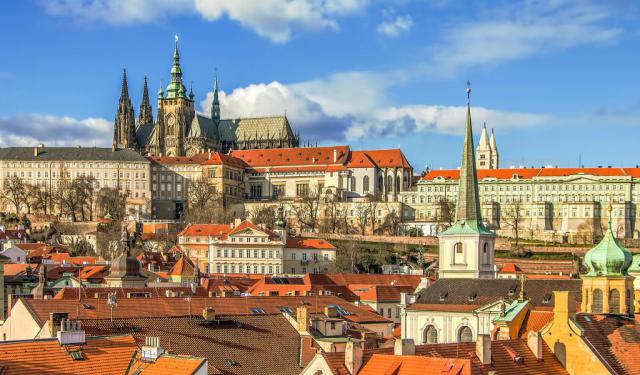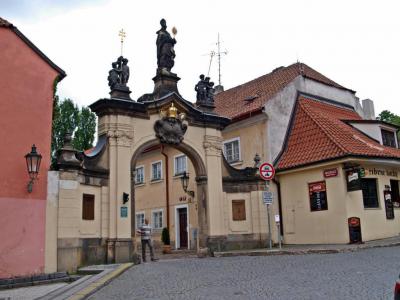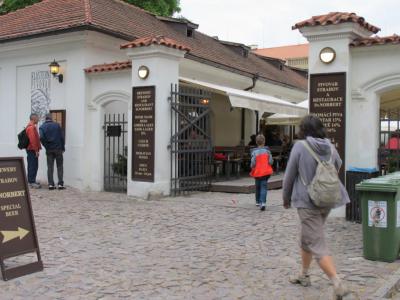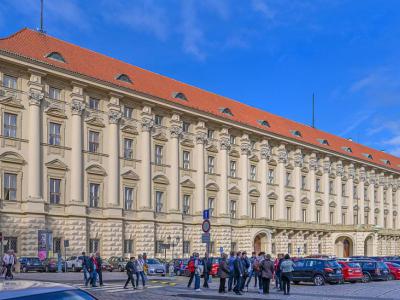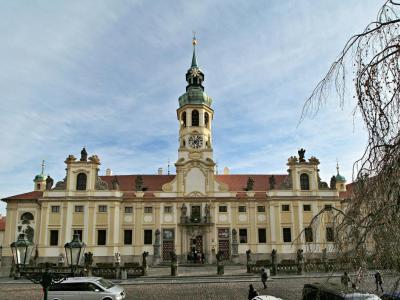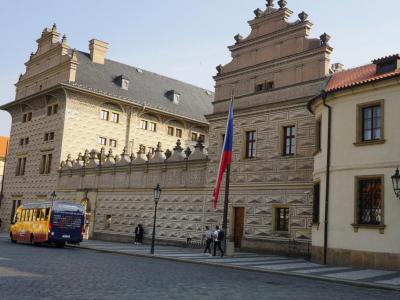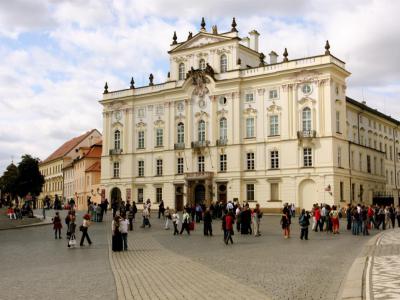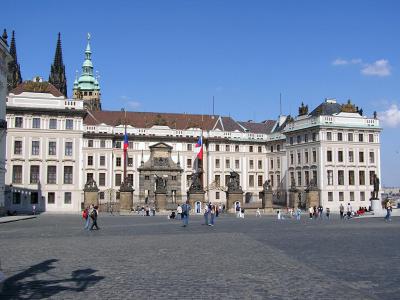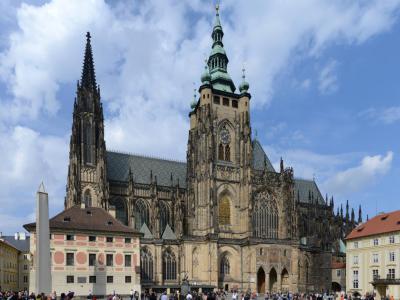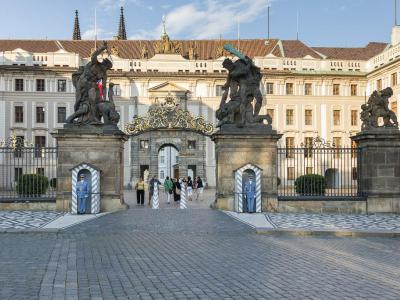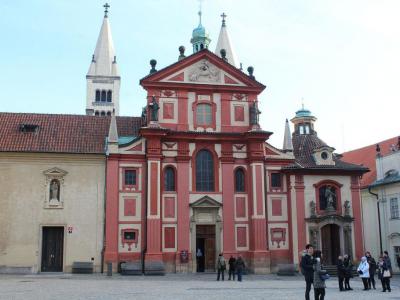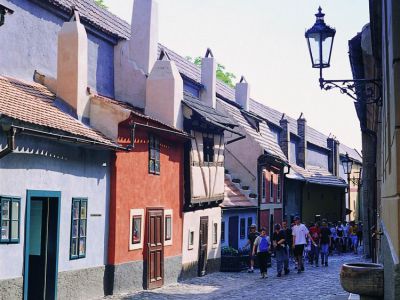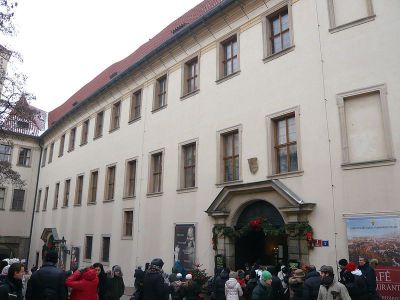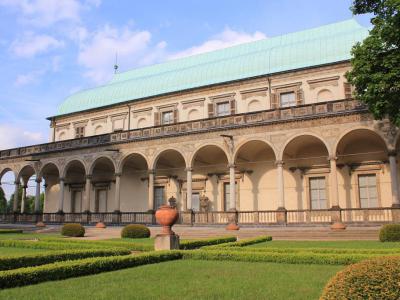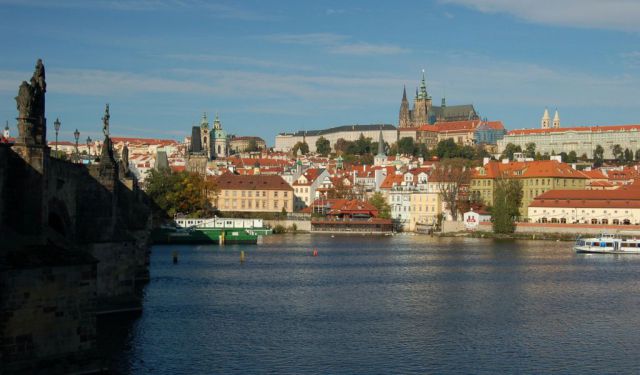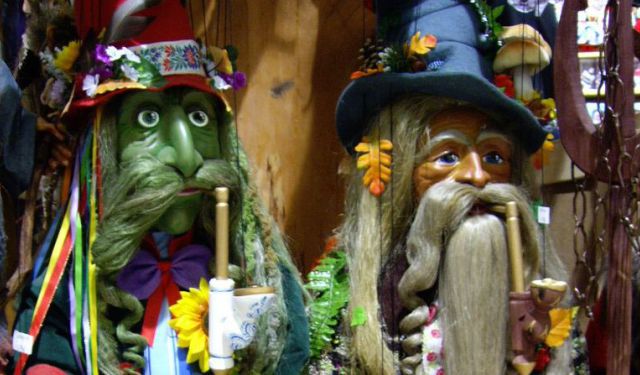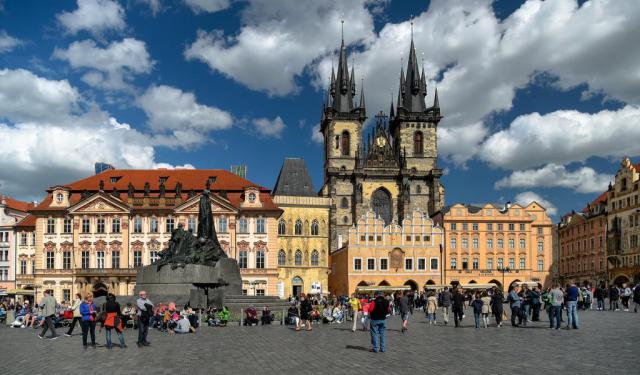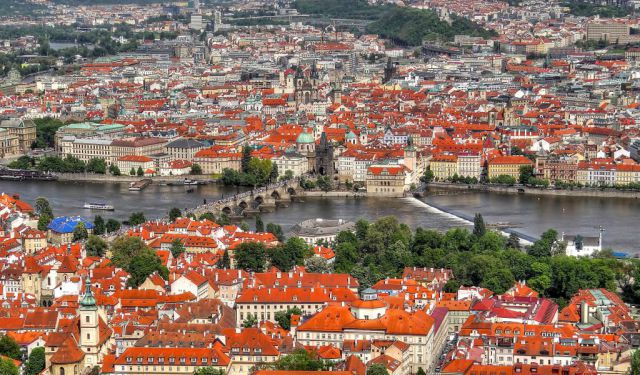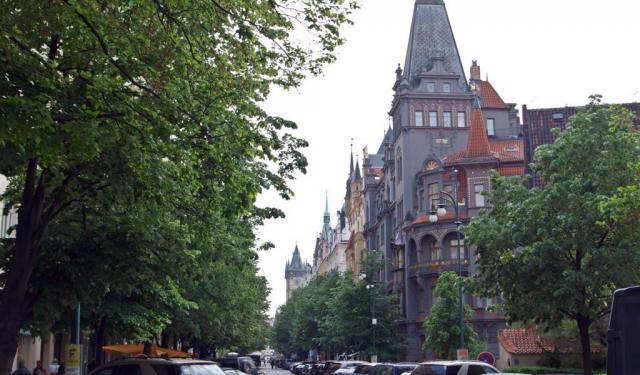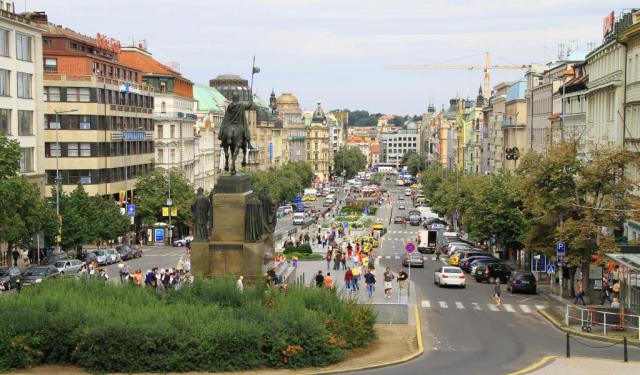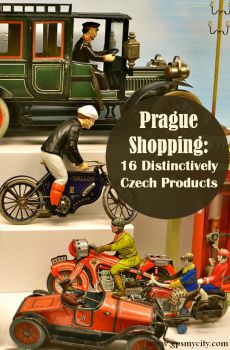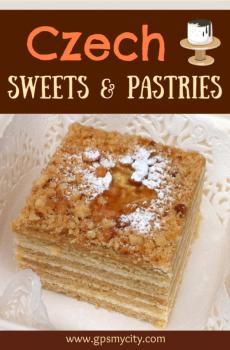Audio Guide: Hradcany (Castle District) Walking Tour (Self Guided), Prague
Prague’s Castle District is a neighborhood where history feels almost tangible-an atmospheric blend of towering landmarks, quiet courtyards, and sweeping city views. At its heart sits the mighty Prague Castle, often cited as the largest castle complex in the world. Its origins stretch back to the 9th century, and over time, it has been home to Bohemian kings, Holy Roman emperors, Communist leaders, and today, the president of the Czech Republic.
Within the castle walls, you'll find some of Prague’s most treasured sights. Saint Vitus Cathedral rises above the skyline with its soaring Gothic spires, sheltering the Czech crown jewels and royal tombs. The Old Royal Palace tells tales of centuries of courtly life and political intrigue, while Saint George’s Basilica invites a quieter kind of reverence within its ancient interior.
Just beyond the main complex, the district continues to impress. The grand Czernin Palace houses the Ministry of Foreign Affairs, and the Schwarzenberg Palace showcases a remarkable Baroque art collection curated by the National Gallery. Across the square, the Archbishop’s Palace adds a touch of Rococo elegance to the area, still serving as the residence of Prague’s highest-ranking Catholic figure.
But the Castle District isn’t only about grandeur-it’s filled with hidden corners, peaceful gardens, and streets that reward slow exploration. Stroll through the serene grounds of the Loreta, a pilgrimage site with bells that chime every hour, or step back in time along the Golden Lane, where tiny, brightly painted cottages recall the lives of medieval tradespeople and castle guards.
Craving something refreshing? Just up the hill is the Strahov Monastic Brewery, where centuries of brewing tradition meet modern-day hospitality. Not far from there, the Lobkowicz Palace displays an extraordinary private art collection, while Villa Richter serves fine meals paired with panoramic views across the city. And tucked into the castle’s northern gardens lies the Belvedere-an elegant Renaissance summer palace surrounded by greenery and serenaded by the melodic waters of the Singing Fountain.
There’s no better way to experience all of this than by setting out on a walking tour. With each step, you’ll uncover centuries of stories, art, and architecture-at your own pace, and with the freedom to linger wherever history speaks to you most.
Within the castle walls, you'll find some of Prague’s most treasured sights. Saint Vitus Cathedral rises above the skyline with its soaring Gothic spires, sheltering the Czech crown jewels and royal tombs. The Old Royal Palace tells tales of centuries of courtly life and political intrigue, while Saint George’s Basilica invites a quieter kind of reverence within its ancient interior.
Just beyond the main complex, the district continues to impress. The grand Czernin Palace houses the Ministry of Foreign Affairs, and the Schwarzenberg Palace showcases a remarkable Baroque art collection curated by the National Gallery. Across the square, the Archbishop’s Palace adds a touch of Rococo elegance to the area, still serving as the residence of Prague’s highest-ranking Catholic figure.
But the Castle District isn’t only about grandeur-it’s filled with hidden corners, peaceful gardens, and streets that reward slow exploration. Stroll through the serene grounds of the Loreta, a pilgrimage site with bells that chime every hour, or step back in time along the Golden Lane, where tiny, brightly painted cottages recall the lives of medieval tradespeople and castle guards.
Craving something refreshing? Just up the hill is the Strahov Monastic Brewery, where centuries of brewing tradition meet modern-day hospitality. Not far from there, the Lobkowicz Palace displays an extraordinary private art collection, while Villa Richter serves fine meals paired with panoramic views across the city. And tucked into the castle’s northern gardens lies the Belvedere-an elegant Renaissance summer palace surrounded by greenery and serenaded by the melodic waters of the Singing Fountain.
There’s no better way to experience all of this than by setting out on a walking tour. With each step, you’ll uncover centuries of stories, art, and architecture-at your own pace, and with the freedom to linger wherever history speaks to you most.
How it works: Download the app "GPSmyCity: Walks in 1K+ Cities" from Apple App Store or Google Play Store to your mobile phone or tablet. The app turns your mobile device into a personal tour guide and its built-in GPS navigation functions guide you from one tour stop to next. The app works offline, so no data plan is needed when traveling abroad.
Hradcany (Castle District) Walking Tour Map
Guide Name: Hradcany (Castle District) Walking Tour
Guide Location: Czech Republic » Prague (See other walking tours in Prague)
Guide Type: Self-guided Walking Tour (Sightseeing)
# of Attractions: 14
Tour Duration: 2 Hour(s)
Travel Distance: 3.0 Km or 1.9 Miles
Author: vickyc
Sight(s) Featured in This Guide:
Guide Location: Czech Republic » Prague (See other walking tours in Prague)
Guide Type: Self-guided Walking Tour (Sightseeing)
# of Attractions: 14
Tour Duration: 2 Hour(s)
Travel Distance: 3.0 Km or 1.9 Miles
Author: vickyc
Sight(s) Featured in This Guide:
- Strahov Monastery
- Strahov Monastic Brewery
- Czernin Palace
- Loreta
- Schwarzenberg Palace
- Archbishop's Palace
- Prague Castle
- St. Vitus Cathedral
- Old Royal Palace
- St. George's Basilica at Prague Castle
- Golden Lane
- Lobkowicz Palace
- Villa Richter
- Belvedere (Royal Summer Palace)
1) Strahov Monastery
Founded in 1120 by Saint Norbert, Strahov has been home to the Premonstratensian order since 1143. Back in its heyday, it rivaled the very seat of the Czech sovereign in scale and influence. Perched high above Prague, the monastery commands sweeping views of the city and has remained remarkably intact over the centuries. When Emperor Joseph II shut down most monastic houses in 1783, Strahov managed to survive by presenting itself as a center of learning-a claim backed up by its extraordinary library, one of the most important in Bohemia.
The library is without question a highlight. With a collection of around 200,000 volumes, it includes everything from rare manuscripts to scientific works. The Theological and Philosophical Halls are lavishly decorated with stucco, wood carvings, and ceiling frescoes. There’s a small fee if you want to take photos, but the visual splendor is worth every crown.
Not far from the library is the Basilica of Our Lady, a serene space rich in Baroque artistry. The frescoes depict scenes from the life of the Virgin Mary, and the organ once resonated with the music of Mozart himself during a visit in 1787. Just off the cloisters, the monastery’s Picture Gallery presents a curated collection of religious art, including church plate and ornate reliquaries-an intimate look at centuries of spiritual life and craftsmanship.
Beyond these cultural treasures, Strahov is also known for its cultural offerings. Classical music concerts are often held within the complex, and for those in search of something heartier, the Strahov Brewery dishes up excellent Czech fare alongside craft beer brewed right on site. If you're feeling especially adventurous, head down to Pelko-the atmospheric cellar restaurant whose name translates, quite fittingly, as “hell.”
The library is without question a highlight. With a collection of around 200,000 volumes, it includes everything from rare manuscripts to scientific works. The Theological and Philosophical Halls are lavishly decorated with stucco, wood carvings, and ceiling frescoes. There’s a small fee if you want to take photos, but the visual splendor is worth every crown.
Not far from the library is the Basilica of Our Lady, a serene space rich in Baroque artistry. The frescoes depict scenes from the life of the Virgin Mary, and the organ once resonated with the music of Mozart himself during a visit in 1787. Just off the cloisters, the monastery’s Picture Gallery presents a curated collection of religious art, including church plate and ornate reliquaries-an intimate look at centuries of spiritual life and craftsmanship.
Beyond these cultural treasures, Strahov is also known for its cultural offerings. Classical music concerts are often held within the complex, and for those in search of something heartier, the Strahov Brewery dishes up excellent Czech fare alongside craft beer brewed right on site. If you're feeling especially adventurous, head down to Pelko-the atmospheric cellar restaurant whose name translates, quite fittingly, as “hell.”
2) Strahov Monastic Brewery
This is the kind of place that checks all the boxes if you’re after an authentic taste of Czech hospitality. Just a short stroll from the historic Strahov Monastery and its legendary library, the brewery serves up a hearty lineup of traditional pub favorites-think golden schnitzel, onion soup, apple strudel, or pork ribs. Every dish is crafted with care, and the service strikes a balance between friendly and efficient.
As for the beer, expect a rotating selection of fresh brews, all made on-site, with enough variety to please both casual sippers and devoted connoisseurs. Prices are reasonable, making it easy to settle in and sample more than one.
In the warmer months, the brewery’s courtyard garden is the real star. Communal wooden tables spill out under the open sky, offering a relaxed and inviting setting. You can also step indoors for a seat at a traditional table surrounded by stone walls and rustic wooden beams. Despite being just minutes from Prague’s city center, the atmosphere feels like a countryside escape-quiet, unhurried, and blessed with views that stretch across the city’s rooftops.
At the Monastic Brewery, time slows down, flavors stand out, and conversations last a little longer. Perfect for lunch after exploring the monastery, and specially lovely on a sunny afternoon when the garden is in full swing.
As for the beer, expect a rotating selection of fresh brews, all made on-site, with enough variety to please both casual sippers and devoted connoisseurs. Prices are reasonable, making it easy to settle in and sample more than one.
In the warmer months, the brewery’s courtyard garden is the real star. Communal wooden tables spill out under the open sky, offering a relaxed and inviting setting. You can also step indoors for a seat at a traditional table surrounded by stone walls and rustic wooden beams. Despite being just minutes from Prague’s city center, the atmosphere feels like a countryside escape-quiet, unhurried, and blessed with views that stretch across the city’s rooftops.
At the Monastic Brewery, time slows down, flavors stand out, and conversations last a little longer. Perfect for lunch after exploring the monastery, and specially lovely on a sunny afternoon when the garden is in full swing.
3) Czernin Palace
Renowned for its largest Baroque palace in Prague, Czernin is impossible to miss-its immense scale and striking façade dominate the quiet square beside the Loreta. Completed in 1682, the construction was so ambitious that two entire streets were wiped off the map just to make room. The man behind it all was Count Humprecht Jan Černín, a former imperial ambassador to Venice with a reputation for grand gestures-and an ego to match.
Stretching 150 meters, the palace front is a visual statement in itself. Thirty Palladian half-columns line the exterior, and the stonework features bold diamond-pointed rustication, giving the building both elegance and weight. Since 1918, it has housed the Czech Ministry of Foreign Affairs-but history took a darker turn during World War II, when it was briefly used as the Nazi governor’s residence.
Yet the building’s most haunting chapter came in March 1948. Just weeks after the Communist coup, Jan Masaryk-foreign minister, son of Czechoslovakia’s founding president, and the last remaining non-Communist in the government-was found dead in the palace courtyard. He had fallen from a bathroom window on the top floor. Official reports called it suicide, but many others believed it was murder. Either way, the event became a defining moment in the postwar history of Czechoslovakia, marking the end of democratic hopes and the beginning of a long era of repression.
Today, the palace remains in official use, and its exterior continues to draw visitors with a taste for history and grand design.
Stretching 150 meters, the palace front is a visual statement in itself. Thirty Palladian half-columns line the exterior, and the stonework features bold diamond-pointed rustication, giving the building both elegance and weight. Since 1918, it has housed the Czech Ministry of Foreign Affairs-but history took a darker turn during World War II, when it was briefly used as the Nazi governor’s residence.
Yet the building’s most haunting chapter came in March 1948. Just weeks after the Communist coup, Jan Masaryk-foreign minister, son of Czechoslovakia’s founding president, and the last remaining non-Communist in the government-was found dead in the palace courtyard. He had fallen from a bathroom window on the top floor. Official reports called it suicide, but many others believed it was murder. Either way, the event became a defining moment in the postwar history of Czechoslovakia, marking the end of democratic hopes and the beginning of a long era of repression.
Today, the palace remains in official use, and its exterior continues to draw visitors with a taste for history and grand design.
4) Loreta
Since the 1620s, the Loreta complex has been one of the most important pilgrimage sites in Bohemia, having taken root during the fervent era of the Counter-Reformation. As the Habsburg monarchs sought to restore Catholic dominance across their empire, they began constructing replicas of Italy’s famed Santa Casa, the Holy House of Loreto. According to legend, the original was believed to be the very home of the Virgin Mary in Nazareth, where the Archangel Gabriel delivered news of Christ’s coming birth. To save it from destruction during the Islamic conquest of the Holy Land, it was said to have been miraculously transported to safety in Europe-some claimed by angels, others by devout Christians.
High above the city in the Castle District, the gleaming white facade of Prague’s Loreta can’t help but catch the eye. More than just a single church, it’s a full Baroque complex-complete with cloisters lined in frescoes, a chapel full of wood-carved cherubs, and a treasury that could rival any royal collection. Among the items on display are golden chalices, ornate vestments, and a jaw-dropping monstrance known as the “Prague Sun,” adorned with 6,222 diamonds. It’s a glittering centerpiece that speaks to the wealth and artistic devotion poured into this space. While the entrance fee is modest, photography inside requires a separate ticket-worth considering if you want to capture the dazzling interiors.
And while you're in the area, consider taking a detour into Nový Svět, or the “New World”-a quiet little pocket just behind Loreta Square. Far from the usual tourist routes, it's an ideal spot for a peaceful walk, a bit of reflection, or just soaking up some of the city’s most romantic charm.
High above the city in the Castle District, the gleaming white facade of Prague’s Loreta can’t help but catch the eye. More than just a single church, it’s a full Baroque complex-complete with cloisters lined in frescoes, a chapel full of wood-carved cherubs, and a treasury that could rival any royal collection. Among the items on display are golden chalices, ornate vestments, and a jaw-dropping monstrance known as the “Prague Sun,” adorned with 6,222 diamonds. It’s a glittering centerpiece that speaks to the wealth and artistic devotion poured into this space. While the entrance fee is modest, photography inside requires a separate ticket-worth considering if you want to capture the dazzling interiors.
And while you're in the area, consider taking a detour into Nový Svět, or the “New World”-a quiet little pocket just behind Loreta Square. Far from the usual tourist routes, it's an ideal spot for a peaceful walk, a bit of reflection, or just soaking up some of the city’s most romantic charm.
5) Schwarzenberg Palace
Easily one of Prague’s most striking architectural marvels, this Renaissance-style palace, built in the 16th century, makes quite the first impression. Its façade was designed to trick the eye with a painted pattern that mimics three-dimensional pyramidal stonework. The effect is so convincing, many passersby assume it’s sculpted relief, when in fact, it's a clever illusion rendered entirely in paint.
Step inside, and you’ll find the interior just as captivating. Ceilings are draped with vast canvas paintings stretched over wooden frames, depicting dramatic scenes like the Judgment of Paris and the Conquest of Troy. Carefully restored during a renovation completed in 2008, these paintings give the rooms a theatrical grandeur that’s hard to ignore.
Today, the palace is part of the National Gallery of Prague and plays host to a rotating calendar of exhibitions. On the ground floor, you’ll find a refined collection of religious art and sculpture. One level up, you’re in the company of Renaissance and Baroque legends-Rubens, Bruegel, El Greco, and Czech master Petr Brandl among them. But the real surprise waits on the top level, where visitors are treated to a formidable collection of Baroque weaponry and armor-helmets, swords, and ornate muskets that once saw ceremonial and battlefield use.
Here’s a handy tip: go for the combined ticket with nearby Sternberg Palace. If you're 26 or younger, you're in luck-the ticket is free. And for everyone else, it offers incredible value, granting access to all National Gallery sites in Prague for 10 days. It’s an art-lover’s passport to some of the city’s finest collections.
Step inside, and you’ll find the interior just as captivating. Ceilings are draped with vast canvas paintings stretched over wooden frames, depicting dramatic scenes like the Judgment of Paris and the Conquest of Troy. Carefully restored during a renovation completed in 2008, these paintings give the rooms a theatrical grandeur that’s hard to ignore.
Today, the palace is part of the National Gallery of Prague and plays host to a rotating calendar of exhibitions. On the ground floor, you’ll find a refined collection of religious art and sculpture. One level up, you’re in the company of Renaissance and Baroque legends-Rubens, Bruegel, El Greco, and Czech master Petr Brandl among them. But the real surprise waits on the top level, where visitors are treated to a formidable collection of Baroque weaponry and armor-helmets, swords, and ornate muskets that once saw ceremonial and battlefield use.
Here’s a handy tip: go for the combined ticket with nearby Sternberg Palace. If you're 26 or younger, you're in luck-the ticket is free. And for everyone else, it offers incredible value, granting access to all National Gallery sites in Prague for 10 days. It’s an art-lover’s passport to some of the city’s finest collections.
6) Archbishop's Palace
Perched on Castle Square, just steps from the Prague Castle, this palace adds a touch of Rococo elegance to the city's most regal address. Originally designed in the Renaissance style, it’s evolved over the centuries to mirror the tastes and ambitions of its powerful occupants. The most dramatic transformation came during the 18th century, when it was remodeled into the pastel pink beauty seen today. Delicate stucco ornamentation, grand arched windows, and the Archbishop’s coat of arms above the main portal lend the entire square a ceremonial feel-especially when flags are flying and uniformed guards are stationed outside during official events.
Though the doors generally remain closed to the public, the exterior alone draws plenty of admiration. The building’s symmetry and refined details provide a charming visual contrast to the fortress-like presence of nearby Prague Castle. On special occasions, the square comes alive with processions and pageantry, making the palace feel very much like a living piece of history.
Behind closed doors lies an interior said to be just as impressive: grand salons, private chapels, intricate woodwork, and even rare 18th-century tapestries imported from Paris. Though access is typically reserved for official functions or special guided tours, there’s one rare exception-on Holy Thursday, the day before Good Friday, the palace opens its doors to the public for a limited time. If your visit happens to align, it’s a golden opportunity to glimpse a world normally kept behind velvet ropes.
Though the doors generally remain closed to the public, the exterior alone draws plenty of admiration. The building’s symmetry and refined details provide a charming visual contrast to the fortress-like presence of nearby Prague Castle. On special occasions, the square comes alive with processions and pageantry, making the palace feel very much like a living piece of history.
Behind closed doors lies an interior said to be just as impressive: grand salons, private chapels, intricate woodwork, and even rare 18th-century tapestries imported from Paris. Though access is typically reserved for official functions or special guided tours, there’s one rare exception-on Holy Thursday, the day before Good Friday, the palace opens its doors to the public for a limited time. If your visit happens to align, it’s a golden opportunity to glimpse a world normally kept behind velvet ropes.
7) Prague Castle (must see)
When you hear “Prague Castle,” you might picture one grandiose palace with spires and regal chambers-but in reality, it’s even more than that. What you're looking at is a vast, fortified complex filled with government buildings, centuries-old churches, art-filled museums, stunning gardens, and the famously charming Golden Lane-where Franz Kafka once lived in a tiny cottage. Covering over 17 acres, or 70,000 square meters, it holds the Guinness World Record as the largest castle complex in existence, and its roots stretch all the way back to the 9th century.
This place has seen centuries of rulers come and go-from medieval kings and Habsburg monarchs to Tomáš Masaryk, the first president of Czechoslovakia. Today, it’s still the official residence of the Czech president, and you can tell when they’re in town by the national flag flying above the entrance. Just outside the main gates, the stoic castle guards carry out the ceremonial changing of the guard every day at noon, with smaller routines each hour starting at 7 a.m.
The architecture here is a timeline in stone-Saint Vitus Cathedral blends Gothic drama with Renaissance and Baroque flourishes, while nearby Saint George’s Basilica keeps things somewhat simpler with a Romanesque interior hidden behind a Baroque facade. You’ll even notice touches from the 20th century scattered across the grounds, making the Castle feel like a living archive of Czech history.
If you’re planning to explore the whole complex, set aside at least 3 to 5 hours-it’s worth taking your time. The castle gardens are open to the public for free, perfect for wandering or simply sitting and soaking up the atmosphere. If the ticket line at the main entrance seems long, try one of the booths deeper in the courtyard-they’re often quicker and easier to access.
This place has seen centuries of rulers come and go-from medieval kings and Habsburg monarchs to Tomáš Masaryk, the first president of Czechoslovakia. Today, it’s still the official residence of the Czech president, and you can tell when they’re in town by the national flag flying above the entrance. Just outside the main gates, the stoic castle guards carry out the ceremonial changing of the guard every day at noon, with smaller routines each hour starting at 7 a.m.
The architecture here is a timeline in stone-Saint Vitus Cathedral blends Gothic drama with Renaissance and Baroque flourishes, while nearby Saint George’s Basilica keeps things somewhat simpler with a Romanesque interior hidden behind a Baroque facade. You’ll even notice touches from the 20th century scattered across the grounds, making the Castle feel like a living archive of Czech history.
If you’re planning to explore the whole complex, set aside at least 3 to 5 hours-it’s worth taking your time. The castle gardens are open to the public for free, perfect for wandering or simply sitting and soaking up the atmosphere. If the ticket line at the main entrance seems long, try one of the booths deeper in the courtyard-they’re often quicker and easier to access.
8) St. Vitus Cathedral (must see)
Rising above the Vltava River from within the grounds of Prague Castle, Saint Vitus Cathedral is hailed as a pinnacle of Gothic architectire and a powerful emblem of Bohemian identity. For generations, it has been the final resting place of kings and emperors, and its very presence resonates with centuries of history. But even if you're not drawn in by royal lineages or historic timelines, the striking façade, sweeping nave, and exquisite stained glass stir something deeper-a quiet sense of awe and reverence that transcends time.
The first thing you'll likely notice is the imposing Great Tower, topped with a Baroque dome and housing Sigismund-the largest bell in Bohemia, cast in the 1500s and weighing in at over 33,000 pounds. Just beside it is the cathedral’s southern entrance-the Golden Gate-famed for its gleaming mosaic of the Last Judgment, crafted from Venetian glass.
Inside, you’re instantly struck by the vertical grandeur of the nave. On the left, the stained-glass windows impart a transcendent aura; particularly the third one-a vivid Art Nouveau piece by Alfons Mucha, which tells the story of Christianity in the Czech lands through a kaleidoscope of color and symbolism. Other highlights include a wooden panorama of old Prague, the extravagant silver tomb of Saint John of Nepomuk, and a fascinating mix of sculptural details that range from sacred to surreal.
A few tips before your visit: entry to the main area and some interior sections is free, but a full tour requires a ticket bundled with Prague Castle access. There’s also an option to climb the tower-for a separate fee-rewarding the ambitious with sweeping views, assuming you're up for the tight staircase.
The first thing you'll likely notice is the imposing Great Tower, topped with a Baroque dome and housing Sigismund-the largest bell in Bohemia, cast in the 1500s and weighing in at over 33,000 pounds. Just beside it is the cathedral’s southern entrance-the Golden Gate-famed for its gleaming mosaic of the Last Judgment, crafted from Venetian glass.
Inside, you’re instantly struck by the vertical grandeur of the nave. On the left, the stained-glass windows impart a transcendent aura; particularly the third one-a vivid Art Nouveau piece by Alfons Mucha, which tells the story of Christianity in the Czech lands through a kaleidoscope of color and symbolism. Other highlights include a wooden panorama of old Prague, the extravagant silver tomb of Saint John of Nepomuk, and a fascinating mix of sculptural details that range from sacred to surreal.
A few tips before your visit: entry to the main area and some interior sections is free, but a full tour requires a ticket bundled with Prague Castle access. There’s also an option to climb the tower-for a separate fee-rewarding the ambitious with sweeping views, assuming you're up for the tight staircase.
9) Old Royal Palace
One of the oldest buildings within Prague Castle, this palace dates all the way back to the 12th century and makes a rewarding stop for anyone with a love of history. Once the seat of Bohemian kings, it now offers a vivid journey into the past-complete with painted coats of arms scattered across its walls and ceilings, and a clever medieval heating system powered by tiled stoves built into the towers.
The palace is most famous for one rather dramatic moment in 1618, when tensions between Catholic and Protestant factions erupted in the Defenestration of Prague. Two Imperial Governors were thrown from a window of the Bohemian Chancellery by rebellious nobles, sparking the bloody Thirty Years’ War. Remarkably, the unlucky officials survived the fall-thanks to a less-than-dignified landing in a manure pile from the nearby Royal Stables.
Setting that infamous moment aside, the centerpiece here is Vladislav Hall, built at the end of the 15th century. Stretching an impressive 60 meters in length, the hall is a masterpiece of late Gothic architecture, featuring a ribbed vaulted ceiling that seems to float above the space like an intricate stone canopy. In centuries past, it was used for everything from banquets and coronations to indoor jousting tournaments, with knights riding up the wide, spiral Rider’s Staircase straight into the hall. These days, it serves as the ceremonial site where Czech presidents are sworn into office-including Václav Havel, who took the oath here in 1990 after the fall of communism.
Don’t miss the small balcony at the eastern end, where you can peek into the neighboring Church of All Saints. Originally built in the 14th century and rebuilt after a devastating fire in 1541, the church is open to the public only during services or special concerts.
Otherwise, keep your eyes on the ceilings. Some of the most spectacular details are high above, waiting to be noticed.
The palace is most famous for one rather dramatic moment in 1618, when tensions between Catholic and Protestant factions erupted in the Defenestration of Prague. Two Imperial Governors were thrown from a window of the Bohemian Chancellery by rebellious nobles, sparking the bloody Thirty Years’ War. Remarkably, the unlucky officials survived the fall-thanks to a less-than-dignified landing in a manure pile from the nearby Royal Stables.
Setting that infamous moment aside, the centerpiece here is Vladislav Hall, built at the end of the 15th century. Stretching an impressive 60 meters in length, the hall is a masterpiece of late Gothic architecture, featuring a ribbed vaulted ceiling that seems to float above the space like an intricate stone canopy. In centuries past, it was used for everything from banquets and coronations to indoor jousting tournaments, with knights riding up the wide, spiral Rider’s Staircase straight into the hall. These days, it serves as the ceremonial site where Czech presidents are sworn into office-including Václav Havel, who took the oath here in 1990 after the fall of communism.
Don’t miss the small balcony at the eastern end, where you can peek into the neighboring Church of All Saints. Originally built in the 14th century and rebuilt after a devastating fire in 1541, the church is open to the public only during services or special concerts.
Otherwise, keep your eyes on the ceilings. Some of the most spectacular details are high above, waiting to be noticed.
10) St. George's Basilica at Prague Castle
Set within Prague Castle’s historic grounds, George Square is home to one of the city’s most remarkable landmarks-Saint George's Basilica, the oldest surviving church building in all of Prague. Founded by Prince Vratislav way back in 921, the church is a study in contrasts. Its vivid red-and-cream Baroque façade, added centuries later, gives little hint of the austere Romanesque design waiting inside. Step through the entrance, and you’re met with a space that feels both solemn and monumental. A double staircase rises toward the high altar, where you'll find beautiful painted decorations on the apse and ceiling.
The basilica’s main nave houses the tombs of several members of the Přemyslid dynasty, the first ruling family of Bohemia.. A large stone coffin contains Boleslav I, remembered in Czech history as Boleslav the Cruel. Just to the right of the central stairs is the Chapel of Saint Ludmila, grandmother to both Boleslav and the much-revered Wenceslas. Ludmila’s legacy looms large-she was instrumental in raising Wenceslas as a Christian, while her daughter-in-law, Drahomíra, remained loyal to the region’s older pagan traditions. That conflict turned deadly, at least according to legend: Ludmila was reportedly strangled with her own scarf on Drahomíra’s orders, a detail often depicted in paintings and statues through the presence of a veil around her neck. The story echoes a recurring Czech theme-spiritual tension between old gods and new faiths, local identity and foreign influence.
Thanks to the basilica’s exceptional acoustics, the space also doubles as a concert venue. Classical performances are held year-round, drawing both seasoned fans and curious newcomers alike. Nearby, you’ll find the former Convent of Saint George, established in 973 by Boleslav II. Today, the quiet building houses part of the National Gallery’s collection, featuring Renaissance and Baroque works in an atmosphere that blends artistic beauty with centuries of monastic calm.
The basilica’s main nave houses the tombs of several members of the Přemyslid dynasty, the first ruling family of Bohemia.. A large stone coffin contains Boleslav I, remembered in Czech history as Boleslav the Cruel. Just to the right of the central stairs is the Chapel of Saint Ludmila, grandmother to both Boleslav and the much-revered Wenceslas. Ludmila’s legacy looms large-she was instrumental in raising Wenceslas as a Christian, while her daughter-in-law, Drahomíra, remained loyal to the region’s older pagan traditions. That conflict turned deadly, at least according to legend: Ludmila was reportedly strangled with her own scarf on Drahomíra’s orders, a detail often depicted in paintings and statues through the presence of a veil around her neck. The story echoes a recurring Czech theme-spiritual tension between old gods and new faiths, local identity and foreign influence.
Thanks to the basilica’s exceptional acoustics, the space also doubles as a concert venue. Classical performances are held year-round, drawing both seasoned fans and curious newcomers alike. Nearby, you’ll find the former Convent of Saint George, established in 973 by Boleslav II. Today, the quiet building houses part of the National Gallery’s collection, featuring Renaissance and Baroque works in an atmosphere that blends artistic beauty with centuries of monastic calm.
11) Golden Lane
One of the most fascinating corners within Prague Castle, Golden Lane is a narrow street lined with brightly colored, pint-sized cottages that feel plucked from a fairy tale. Walking along the cobblestones, past vivid facades and tiny windows, you’re stepping into the last surviving example of the Castle’s more humble, small-scale architecture.
The lane dates back to the 16th century, originally built to house castle guards. It later took its name from the goldsmiths who moved in a hundred years later. By the 1800s, it had evolved into a sort of artistic enclave, drawing in poets and craftsmen. Franz Kafka spent time here in 1916, writing in a small cottage during long winter evenings, and Jaroslav Seifert, a future Nobel Prize laureate, also called the lane home.
Although people lived in these tiny houses up until World War II, they’ve since been carefully restored, keeping their original charm intact. Inside, you’ll find exhibits of medieval armor and weapons, alongside displays of period textiles-and yes, a few cozy souvenir shops and snack bars. The lane ends at Daliborka Tower, once a prison, where you can view historical torture devices-a darker but compelling window into the past.
Tip: If you have a castle ticket, entry is included. But if you’re looking to stroll through just for the atmosphere, come after 5 p.m. when the path is freely open-though most interiors will be closed by then.
The lane dates back to the 16th century, originally built to house castle guards. It later took its name from the goldsmiths who moved in a hundred years later. By the 1800s, it had evolved into a sort of artistic enclave, drawing in poets and craftsmen. Franz Kafka spent time here in 1916, writing in a small cottage during long winter evenings, and Jaroslav Seifert, a future Nobel Prize laureate, also called the lane home.
Although people lived in these tiny houses up until World War II, they’ve since been carefully restored, keeping their original charm intact. Inside, you’ll find exhibits of medieval armor and weapons, alongside displays of period textiles-and yes, a few cozy souvenir shops and snack bars. The lane ends at Daliborka Tower, once a prison, where you can view historical torture devices-a darker but compelling window into the past.
Tip: If you have a castle ticket, entry is included. But if you’re looking to stroll through just for the atmosphere, come after 5 p.m. when the path is freely open-though most interiors will be closed by then.
12) Lobkowicz Palace
Tucked inside the sprawling grounds of Prague Castle, there's one building that doesn’t belong to the state-and almost never did. This 16th-century palace, still in the hands of the Lobkowicz family, made its way back into aristocratic ownership after the fall of communism. These days, it's not just a relic of the past, but very much alive with purpose. Part museum, part event venue, part midday concert escape, it's got culture and character to spare. And yes, the terrace view here is a full 180 degrees of cityscape-best enjoyed with the 30-minute “Prague Inspires Panorama Tour” offered with each audio guide.
The guide is voiced by the Lobkowicz family themselves, walking you through centuries of history and art. Expect an all-star lineup, including Canaletto, Brueghel the Elder, and Velázquez. There’s also a treasure trove of arms, armor, and ceramics-including the world’s largest surviving Delft dinner service. And for music lovers-original manuscripts by Beethoven, Mozart, and Haydn are on display, including pieces Beethoven composed specifically for the Lobkowicz family.
The palace’s reception halls, balconies, and the concert space are all decked out with lavish mythological frescoes, while the Imperial Hall tricks the eye with Roman statues that aren’t statues at all. Otherwise, don’t miss the 17th-century chapel dedicated to Saint Wenceslas, where medallions on the walls retell the saga of the Czech Republic’s patron saint.
Tip: Once your museum journey winds down-and your head’s buzzing with beauty and history-swing by the museum shop for a keepsake, then recharge at the café. It caters to all cravings, and rumor has it their burgers might just be the best in town.
The guide is voiced by the Lobkowicz family themselves, walking you through centuries of history and art. Expect an all-star lineup, including Canaletto, Brueghel the Elder, and Velázquez. There’s also a treasure trove of arms, armor, and ceramics-including the world’s largest surviving Delft dinner service. And for music lovers-original manuscripts by Beethoven, Mozart, and Haydn are on display, including pieces Beethoven composed specifically for the Lobkowicz family.
The palace’s reception halls, balconies, and the concert space are all decked out with lavish mythological frescoes, while the Imperial Hall tricks the eye with Roman statues that aren’t statues at all. Otherwise, don’t miss the 17th-century chapel dedicated to Saint Wenceslas, where medallions on the walls retell the saga of the Czech Republic’s patron saint.
Tip: Once your museum journey winds down-and your head’s buzzing with beauty and history-swing by the museum shop for a keepsake, then recharge at the café. It caters to all cravings, and rumor has it their burgers might just be the best in town.
13) Villa Richter
After exploring the grounds of Prague Castle, Villa Richter offers a welcome retreat with one of the best views in the city. Tucked among the terraced vineyards just below the Black Tower, the villa feels worlds away from the crowds, yet remains within a stone’s throw of the castle walls. It’s a perfect place to pause, recharge, and take in sweeping views of Prague’s rooftops, bridges, and spires.
The villa is home to three distinct dining experiences, each with its own personality. At the top sits Piano Nobile, known for refined dishes featuring duck, beef, and fresh seafood-ideal for a lingering lunch with flair. Below that is Piano Terra, where the focus shifts to comforting Bohemian classics served with an elegant twist. Further in, you’ll find the Wine Tresor, a more intimate space dedicated to showcasing the best of Czech winemaking, all with that stunning backdrop still in view.
Now, let’s be honest-restaurants perched along major tourist routes often promise more than they deliver. The views may be stellar, but the food and service-not always up to par. Villa Richter is a refreshing exception. While it leans upscale, the experience delivers across the board: the cuisine is thoughtfully prepared, the service warm and attentive, and the setting nothing short of magical.
A standout feature here is the opportunity to enjoy wines produced right in the surrounding Saint Wenceslas vineyards-some of the oldest in Bohemia. Sipping a crisp local white on the terrace or settling in for a full-course meal indoors adds a poetic sense of place to the experience. The combination of refined flavors, historic atmosphere, and attentive service creates a setting that feels both indulgent and genuinely rooted in Prague’s heritage.
The villa is home to three distinct dining experiences, each with its own personality. At the top sits Piano Nobile, known for refined dishes featuring duck, beef, and fresh seafood-ideal for a lingering lunch with flair. Below that is Piano Terra, where the focus shifts to comforting Bohemian classics served with an elegant twist. Further in, you’ll find the Wine Tresor, a more intimate space dedicated to showcasing the best of Czech winemaking, all with that stunning backdrop still in view.
Now, let’s be honest-restaurants perched along major tourist routes often promise more than they deliver. The views may be stellar, but the food and service-not always up to par. Villa Richter is a refreshing exception. While it leans upscale, the experience delivers across the board: the cuisine is thoughtfully prepared, the service warm and attentive, and the setting nothing short of magical.
A standout feature here is the opportunity to enjoy wines produced right in the surrounding Saint Wenceslas vineyards-some of the oldest in Bohemia. Sipping a crisp local white on the terrace or settling in for a full-course meal indoors adds a poetic sense of place to the experience. The combination of refined flavors, historic atmosphere, and attentive service creates a setting that feels both indulgent and genuinely rooted in Prague’s heritage.
14) Belvedere (Royal Summer Palace)
At the eastern edge of the Royal Garden, just north of Prague Castle, stands one of the city's most elegant Renaissance treasures-the Royal Summer Palace, often called the Belvedere. Commissioned in the mid-1500s by Emperor Ferdinand I as a romantic gesture for his wife, Queen Anne, the palace was designed by Italian architects and has long been celebrated as one of the finest examples of Renaissance architecture north of the Alps.
Its most striking feature is the unique copper roof, shaped like the hull of an inverted ship, which hovers gracefully above the ground-floor arcades. These arcades are supported by thirty-six columns, and between them you'll find a stunning collection of 114 sculpted reliefs. They bring to life scenes from royal hunts, ancient battles, and classical myths-but also offer more intimate moments, including one particularly touching depiction of Ferdinand presenting a flower to his queen.
Somewhat secluded from the main castle complex, the palace was originally used as an observatory. Today, the upper floor is home to a large fresco that illustrates key episodes from Czech history. The lower level, once filled with drawing rooms and ballrooms, now hosts rotating exhibitions that spotlight both fine art and traditional crafts.
Just outside, the palace is adjoined by a small, geometrically-arranged Renaissance garden known as the “giardinetto”. At its heart stands the famed Singing Fountain, a collaborative work between Italian designers and Czech craftsmen. As water cascades into the basin, it creates a gentle, bell-like sound that gives the fountain its name. For those curious to truly hear the melody, the best approach is to crouch near the rim of the basin, where the acoustics bring out the soft music of the flowing water.
Its most striking feature is the unique copper roof, shaped like the hull of an inverted ship, which hovers gracefully above the ground-floor arcades. These arcades are supported by thirty-six columns, and between them you'll find a stunning collection of 114 sculpted reliefs. They bring to life scenes from royal hunts, ancient battles, and classical myths-but also offer more intimate moments, including one particularly touching depiction of Ferdinand presenting a flower to his queen.
Somewhat secluded from the main castle complex, the palace was originally used as an observatory. Today, the upper floor is home to a large fresco that illustrates key episodes from Czech history. The lower level, once filled with drawing rooms and ballrooms, now hosts rotating exhibitions that spotlight both fine art and traditional crafts.
Just outside, the palace is adjoined by a small, geometrically-arranged Renaissance garden known as the “giardinetto”. At its heart stands the famed Singing Fountain, a collaborative work between Italian designers and Czech craftsmen. As water cascades into the basin, it creates a gentle, bell-like sound that gives the fountain its name. For those curious to truly hear the melody, the best approach is to crouch near the rim of the basin, where the acoustics bring out the soft music of the flowing water.
Walking Tours in Prague, Czech Republic
Create Your Own Walk in Prague
Creating your own self-guided walk in Prague is easy and fun. Choose the city attractions that you want to see and a walk route map will be created just for you. You can even set your hotel as the start point of the walk.
Lesser Town Walking Tour
Malá Strana, or the “Lesser Town,” lies along the left bank of the Vltava River and remains one of Prague’s most charming and historically layered districts. In medieval times, it was primarily settled by ethnic Germans, and even as Baroque architecture reshaped the neighborhood following the devastating fire of 1541, the area held onto its Germanic roots for generations. Its location near... view more
Tour Duration: 2 Hour(s)
Travel Distance: 3.9 Km or 2.4 Miles
Tour Duration: 2 Hour(s)
Travel Distance: 3.9 Km or 2.4 Miles
Old Town Souvenir Shopping
Strolling through the Old Town of Prague, souvenir shopping becomes a delightful adventure. Indeed, it would be a pity to leave Prague without having explored its specialty shops and bringing home something truly original and unique to the city.
One of the prime spots for such endeavors is the Municipal House, a majestic Art Nouveau building that houses various shops and boutiques. Here,... view more
Tour Duration: 1 Hour(s)
Travel Distance: 1.7 Km or 1.1 Miles
One of the prime spots for such endeavors is the Municipal House, a majestic Art Nouveau building that houses various shops and boutiques. Here,... view more
Tour Duration: 1 Hour(s)
Travel Distance: 1.7 Km or 1.1 Miles
Old Town Walking Tour
Prague’s Old Town is a living tapestry of medieval roots and vibrant modern life, wrapped in narrow cobblestone streets and brimming with architectural treasures. Once a self-contained settlement, it was protected by a semi-circular moat and a fortified wall, both tracing the curve of the Vltava River. Although the moat is long gone, its path survives in the form of key streets-most notably Na... view more
Tour Duration: 2 Hour(s)
Travel Distance: 2.8 Km or 1.7 Miles
Tour Duration: 2 Hour(s)
Travel Distance: 2.8 Km or 1.7 Miles
Prague Introduction Walking Tour
Nicknamed the “City of a Hundred Spires,” Prague is a living gallery of history and architecture, home to world-class museums, eclectic galleries, numerous theaters, and a seemingly endless collection of historic landmarks.
The name Praha comes from the old Slavic word “práh”, which means “rapid”, nodding to the city's beginnings at a crossing on the Vltava River. Legend... view more
Tour Duration: 2 Hour(s)
Travel Distance: 3.2 Km or 2 Miles
The name Praha comes from the old Slavic word “práh”, which means “rapid”, nodding to the city's beginnings at a crossing on the Vltava River. Legend... view more
Tour Duration: 2 Hour(s)
Travel Distance: 3.2 Km or 2 Miles
Jewish Quarter Walking Tour
The Jewish Quarter of Prague carries over a thousand years of memory etched into its streets, synagogues, and gravestones. Jewish communities began settling in this area as early as the 10th century, and although they were later forced into a walled ghetto, they cultivated a vibrant cultural and intellectual life-especially during the 16th century, a golden age shaped by the influence of Rabbi Ben... view more
Tour Duration: 1 Hour(s)
Travel Distance: 1.1 Km or 0.7 Miles
Tour Duration: 1 Hour(s)
Travel Distance: 1.1 Km or 0.7 Miles
New Town Walking Tour
The youngest (founded in 1348) and the largest (three times the size of the Old Town), the New Town (or Nove Mesto) of Prague is one of the five originally independent townships that today form the historic center of the Czech capital. This vibrant district offers a mix of historical charm and modern amenities and is traditionally dense with tourists.
At its heart lies Wenceslas Square, a... view more
Tour Duration: 2 Hour(s)
Travel Distance: 3.1 Km or 1.9 Miles
At its heart lies Wenceslas Square, a... view more
Tour Duration: 2 Hour(s)
Travel Distance: 3.1 Km or 1.9 Miles
Useful Travel Guides for Planning Your Trip
Prague Shopping: 15 Distinctively Czech Products to Bring Home
Previously known mainly for its beer and ice-hockey (both for a very good reason), today's Czech Republic - and, primarily, its capital city Prague - is seen among the top European tourist destinations emerged following the breakup of the Soviet Bloc. A shooting ground for some Hollywood...
Czech Sweets and Pastries
Once part of the Austro-Hungarian Empire, the Czechs have duly absorbed the dessert-making know-how of their Austrian neighbors to complement their own confectionery heritage deeply rooted in the Eastern European, Slavic tradition. The end result of such cultural blend is the abundance of pastries,...
The Most Popular Cities
/ view all
